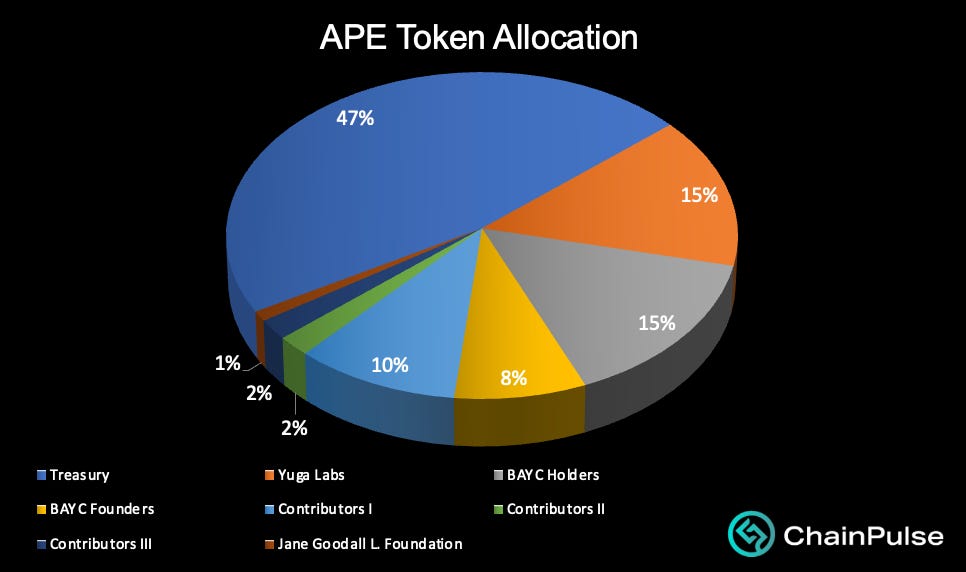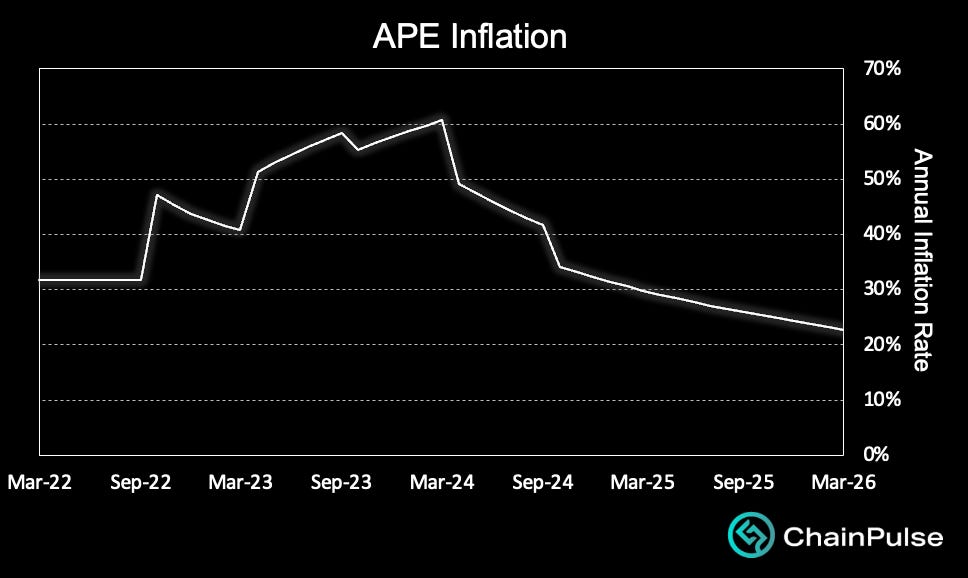The four billion dollar brand known as Bored Ape Yacht Club (BAYC) set the tone for future digital art NFT collections when it dropped a token in March 2022.
In the wake of the drop, sound bites and 280 character Twitter takes were the extent of opinions that existed.
But once the dust settled, and a distraction via a newly released protocol shifted everybody’s attention away from the drop, our team at ChainPulse still had questions about ApeCoin.
Specifically, what type of opportunity does APE present. What are the token economics of this project, and what are some considerations that need to be made when it comes to APE.
These are the questions we addressed internally. After we were finished, we decided to pass along a section of the report with the rest of crypto.
But before we get into the allocation, supply schedules, and discussion… let us first look back on how BAYC got to its most recent headline grabbing event.
The Bored Ape’s Evolution
10,000 Bored Apes burst onto the scene in April 2021. It started with a group of four individuals known as Yuga Labs. The team took in about $2 million with each ape selling for about $200.
Since launch, this collection has realized greater than $1 billion in sales. And through a 2.5% royalty on secondary sales, Yuga Labs netted $127 million in revenue last year. The team is sitting on a sizable warchest.
But the team didn’t stop there.
The entity behind the BAYC NFTs then went on to raise funds via the private market. It was rumored in February 2022 the financing round was underway.
The combination of an ongoing funding round and steady revenue stream from royalties helped the Yuga Labs team bring notable collections such as Cryptopunks and Meebits in rapid succession. It was all in preparation for their next move...
An NFT based metaverse called Otherside.
Otherside is a metaverse that is believed to bring together the NFT industry’s most notable digital collectibles in its virtual world.
Here’s a screengrab of a teaser video that whets the palate by showcasing various NFT collections - some of which Yuga Labs owns the IP to.
Source: Twitter @yubalabs
And with an added revenue stream via selling land parcels, it expects to rake in $455 million in 2022. A 3.5x uptick from 2021 numbers.
While the numbers being thrown are monstrous, the truth is that there is no other entity with an opportunity as big as Yuga Labs. Riding on the success of the BAYC and through IP acquisition, Yuga Labs is the most dominant NFT brand in the market.
Just how dominate?
What started as a meme-esque feeling of wealthy crypto ‘apeing’ millionaires doing weird things in a swamp has now become part of popular culture… Serving as a social status symbol.
The apes have been tied to celebrities such as Eminem, Gwyneth Paltrow, Shaq, Snoop Dogg, Stephen Curry, Paris Hilton, Jimmy Fallon, and Serena Williams among others. No other NFT project comes close to this notoriety.
By default, Yuga Labs is paving the way for future projects to either model after their success or learn from their mistakes.
Which is what makes the two most recent move all the more attention grabbing.
On March 16th Yuga Labs announced it was minting one billion Ethereum ERC-20 tokens called ApeCoin (APE).
The token would be made instantly available for BAYC NFT holders, the treasury, and a small slug for launch contributors.
The rest got locked up for later release, which we will dive into shortly.
What’s more important is what Yuga Labs said the token was for… culture (this is the DAO component), gaming, and commerce.
Gaming is the key word in all of this.
The second interesting event that happened was the announcement made a few days after the drop… The team closed a $450 million financing round led by a16z, which values the company at $4 billion. Animoca Brands is another notable name who took part - remember, gaming is the key word in what the coin is for.
This financing is pretty massive. It brings in two of the biggest names in the cryptocurrency market and NFT/metaverse/gaming sector.
A round this big does not take place unless there is something substantial being built out.
Based upon the teaser video, the word “gaming” in the token’s utility, Animoca’s involvement, and the leaked pitch deck of Yuga Labs saying the parcels of land will contain natural resources, artifacts, and more… It is clear that Otherside is looking to roll out the biggest game title in blockchain yet.
But instead of speculating on how APE will fit into Otherside or other games that will be associated with Yuga’s brands… Let’s look at what we do know.
Specifically, is the token a buy? If it isn’t a buy now, will it be later?
Put in an overly stuffy manner… Does the APE token have sound economic fundamentals?
To decide, we dug into the token further.
The APE’ing Allocation
The distribution of one billion APE tokens is summed up with the pie chart below. As you can see, there are eight parties involved… Which we can actually boil down to five.
The first party is composed of Yuga Labs and BAYC founders.
This accounts for 23% of the supply, making it one of the most important groups to track onchain going forward. Whether or not the APE token creation event is to drive more value to the brand/community over time or served as a way to cash out on the brand’s value will be determined primarily by watching this group. Recall, Yuga Labs is backed by investors like a16z and Animoca… Which is why ChainPulse is watching the wallets associated with this group.
The second group is the treasury, which is the bulk of supply.
Sitting at nearly half, this will fund projects determined by the DAO. This is the portion of the supply that can bring value to APE, BAYC NFTs, and Yuga Labs moving forward.
It’ll also serve as the primary method to incentivize and bootstrap new users to its metaverse game.
Next, there are the BAYC holders who pocketed 15%. Contributors get 14%. And then the Jane Goodall Foundation rounds out the allocation with the final 1%.
To sum up the chart, it shows the way in which the one billion tokens will be split over time. It does not breakdown when these tokens are made available.
To see how these tokens are released to the various parties over time, we can view the emission’s chart below.
The treasury and BAYC holders received the bulk of tokens on day one.
If we track the top line of the chart we see three notable upticks in supply. These dates coincide with releases earmarked for Contributors I.
What is harder to see is one of those three ticks coincide with the most important demographic beginning to receive their supply -Yuga Labs and BAYC Founders. It hints at the biggest influx of supply… Which is set to unfold after 12-months.
To more easily see the three notable dates as well as what will happen after the 12-month lockup period ends, we added the chart below. It is a chart of new supply released each monthly.
The three months mentioned earlier are now much more clear. The first monthly spike is just over 32 million tokens while the latter two monthly spikes are just over 40 million.
Outside those outliers the new monthly supply comes to just over 7.3 million per month. Then after a year it jumps to 15.6 million.
Now in the context of APE’s current $14 billion fully diluted valuation, this new supply is very relevant.
Fully Diluted Value (FDV) is the value of all one billion tokens multiplied by the token’s price.
For APE to realize no change on its token price or market cap, we can do some back of the envelope math…
With 9.4 million APE tokens on average entering the market each month over the next year, this implies a need for about $132 million of monthly demand or $4.4 million per day that needs to enter the market to soak up new supply.
Said plainly, that is a lot of supply hitting the market relentlessly day after day after day.
To showcase this issue a bit differently, we can view the token’s circulating supply over time from an inflationary perspective.
In the chart below we mapped out APE’s expected inflation rate. As you can see, inflation gets worse before better.
With these supply unlocks and substantial inflation in the first year, it begs the question to the market…
How will Yuga Labs, BAYC, the DAO, and venture firms (a16z and Animoca) generate the needed demand? Is it even possible?
Discussion
There are further considerations that need to be made when looking at APE as well as Yuga Labs and its BAYC NFTs.
These thoughts can be summarized into three categories: supply, token design, and the brand. Depending on how the ecosystem responds to these three things will likely dictate its success or failure.
Supply
To start, the rate of new supply taking place with APE is only a general guideline. What happens moving forward will certainly unfold differently than what the charts above suggest.
An example of what we mean can be seen with the treasury funds…
The treasury has an initial allocation of 117.5 million tokens. Then 7.3 million tokens get added each month until all 470 million tokens have been sent.
The important distinction here is that these tokens don’t hit the market right away. If anything, these tokens can hit the market with unscheduled timing and act like sudden supply shocks to the market. That’s because the act of unlocking tokens and depositing them in the treasury is simply a different and semi-liquid lock up vehicle.
Which means how the treasury spends these tokens need to be considered. Is APE being used to pay for salaries? If so, is APE transferred to USD upon receipt?
Similar concerns for yield or incentive programs for future games… What happens to the token once users receive it? Is there a reason for the user to continue to opt-in to the APE economy? Or will they sell it for a different token or store of value?
Giving consideration to these secondary behaviors should be a crucial component to decision making. And done well, means the difference between long-term success or a lesson in history.
In saying this, we would like to point out that onchain analysis commonly is used for very general viewpoints - a broad stroke approach.
Useful onchain analysis and tracking requires a much more systematic approach with a custom set of tools. Which is why ChainPulse labeled various wallets it considers associated with various parties (a16z uses a nice script for token management, so consider this when looking at total APE wallet holders)
Monitoring the treasury spends and BAYC founders/Yuga Labs wallets we can gain better visibility into the APE token economy... And respond more timely to new market supply. But more on that later…
APE Token Design
The second category APE investors need to assess is future token design.
If the metaverse and any other use cases for the token incorporates a design that 1) acts as a way to subdue inflationary effects 2) creates transactional volume that the DAO captures for operational funding and 3) figures out how to recirculate revenue/tokens to incentivize users… then the ecosystem has unmatched potential in the market.
These three items will either showcase the thoughtfulness of the designers or highlight the shortsightedness of the APE toke drop.
We can’t articulate more specifically on these three things because details have not yet surfaced on ways the token can be used.
Which is why current investment decisions regarding APE are primarily based on its token allocation and supply schedule.
However, once future plans are revealed for APE, the three considerations around the token’s token design made earlier can be addressed.
This also implies if the team delays its plans on revealing the token’s main use cases (ie - Otherside, land parcels, staking, P2E uses) the impact on the token’s price in such a high inflationary environment will likely be exagerrated.
Without explicit expectations for how the token will be used… the unlocking schedule will act like a rising sun on ice.
With an inflation rate climbing over 50% in the next year the token does not have time on its side for any delays.
The Brand
The last consideration investors need to be aware of is the one regarding Yuga Labs as a brand.
Yuga Labs and their BAYC NFT is its premier asset (as of now). Which means what the Yuga Labs team decides to do moving forward will predominately impact BAYC.
The capital Yuga Labs just raised along with its future token allocation builds its coffers for later deployment. This gives the team the ability to source better technology, artists, and resources that translates to higher potential asset values later if used wisely.
From this line of thinking, the APE token might prove to be most valuable to the BAYC line. It is likely that the expectation of a token drop in part led to the $4 billion valuation the team received. Whether or not anybody acted on insider knowledge of an upcoming token drop is something we can leave up to @zachxbt to sift through.
One last consideration that should be made here is in regards to Yuga Lab’s BAYC premier line…
With greater resources it should not surprise the market if Yuga Labs introduces an even more prestigious line to come. One that leverages better tech, artists, and resources.
In that same line of thinking it should not be a surprise either if a more accessible NFT hits the market for use in the Otherside NFT metaverse. This way more users can access the virtual world and also APE’s marketshare will grow in tandem.
What is apparent with APE is that there is a lot to consider. Not all of our concerns can be answered today.
But what we do know is that inflation here is a big concern. This can be overcome through proper treasury management and strong token design. Any delay in a use case for APE means its community is leaving the token highly exposed.
It’ll be a topic we will check back on in due time and when new plans are announced.
Until then, thank you for reading.
Who is ChainPulse?
Source: Twitter @yugalabs
The APE token is a project that is setting the tone for NFTs. Any project that follows will either emulate portions of their plan or iterate on their attempts.
With such a high following and highly controversial project, the team at ChainPulse decided to publish this report to spark a token economics conversation.
Our passion is token economics. And we see a future where token economies result in a more efficient, productive, and equitable global population. But before we can get there, we need to better understand the seemingly dormant powers these economies possess. Which means we need to study the successes and failures of various tokens.
Through this study, we as builders can unlock these dormant powers for revolutionary benefits.
You can expect to hear more from our team in the months to come as we get near the release of our upcoming product suite. For now, be sure to sign up to this substack to be one of the first to know of anything new we publish or announce.
P.S. - If you are a project looking for token design consulting, please reach us at support@chainpulse.com. Thank you again for taking the time and reading our work.











I heard that you have paid subscriptions. Can I get more information?
Great read, Ben. Always appreciate your insight into the markets and various projects. It's certainly gonna be exciting to see how APE and the entire Yuga Labs ecosystem plays out...